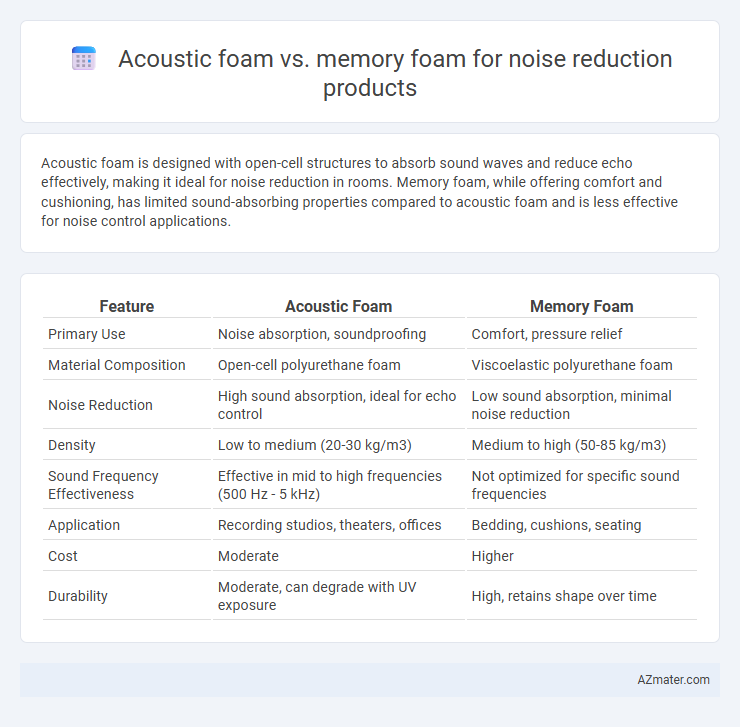Acoustic foam is designed with open-cell structures to absorb sound waves and reduce echo effectively, making it ideal for noise reduction in rooms. Memory foam, while offering comfort and cushioning, has limited sound-absorbing properties compared to acoustic foam and is less effective for noise control applications.
Table of Comparison
| Feature | Acoustic Foam | Memory Foam |
|---|---|---|
| Primary Use | Noise absorption, soundproofing | Comfort, pressure relief |
| Material Composition | Open-cell polyurethane foam | Viscoelastic polyurethane foam |
| Noise Reduction | High sound absorption, ideal for echo control | Low sound absorption, minimal noise reduction |
| Density | Low to medium (20-30 kg/m3) | Medium to high (50-85 kg/m3) |
| Sound Frequency Effectiveness | Effective in mid to high frequencies (500 Hz - 5 kHz) | Not optimized for specific sound frequencies |
| Application | Recording studios, theaters, offices | Bedding, cushions, seating |
| Cost | Moderate | Higher |
| Durability | Moderate, can degrade with UV exposure | High, retains shape over time |
Introduction to Acoustic Foam and Memory Foam
Acoustic foam is specially engineered to absorb sound waves, reducing noise, echo, and reverberation within indoor environments, making it ideal for studios, theaters, and offices. Memory foam, primarily designed for comfort and support in mattresses and cushions, also has some sound absorption properties due to its dense, viscoelastic structure but is less effective than acoustic foam for noise reduction. The key difference lies in their material composition and purpose: acoustic foam uses open-cell polyurethane or melamine to trap and dissipate sound energy, while memory foam focuses on pressure relief with limited acoustic benefits.
Key Differences Between Acoustic Foam and Memory Foam
Acoustic foam is specifically designed with open-cell polyurethane structures to absorb sound waves and reduce echo, making it ideal for noise reduction in studios and rooms. Memory foam primarily serves as a cushioning material that conforms to pressure and body shape, with limited capability to attenuate sound due to its denser and closed-cell composition. The key difference lies in acoustic foam's superior sound absorption properties versus memory foam's focus on comfort and support.
Material Composition and Structure
Acoustic foam is primarily composed of open-cell polyurethane or melamine resin, designed with a porous, wedge-shaped structure that absorbs and diffuses sound waves, effectively reducing echoes and reverberation. Memory foam, made from viscoelastic polyurethane, features a denser, closed-cell structure intended for pressure relief, which provides limited sound absorption and noise reduction compared to acoustic foam. The porous architecture of acoustic foam enhances sound dampening by trapping air vibrations, whereas the dense, slow-rebounding nature of memory foam mainly aids in cushioning rather than acoustic treatment.
Sound Absorption Properties
Acoustic foam exhibits superior sound absorption properties due to its open-cell structure, effectively reducing echo and high-frequency noise in indoor environments. Memory foam, while primarily designed for comfort, provides limited sound absorption because of its denser, closed-cell composition, which traps less airborne sound. For optimal noise reduction, acoustic foam remains the preferred material in professional soundproofing and acoustic treatment applications.
Effectiveness in Noise Reduction
Acoustic foam is specifically engineered to absorb sound waves, reducing echoes and background noise by minimizing reverberation in a room, making it highly effective for noise reduction in studio and office environments. Memory foam, while excellent for cushioning and comfort, has minimal impact on sound absorption due to its dense and less porous structure, which does not effectively dissipate sound energy. For targeted noise reduction, acoustic foam provides a scientifically optimized solution designed to enhance acoustic performance in various settings.
Applications in Noise Control
Acoustic foam excels in noise control by absorbing sound waves and reducing echo in environments such as recording studios, home theaters, and offices. Memory foam, while primarily designed for comfort and support, can provide secondary noise reduction by dampening airborne sounds in products like mattress toppers or pillows. Acoustic foam remains the preferred material for targeted soundproofing and acoustic treatment due to its porous structure and specialized sound-absorbing properties.
Durability and Maintenance
Acoustic foam offers superior durability for long-term noise reduction as it resists deformation and maintains its shape under frequent use. Memory foam, while providing excellent sound absorption due to its density, tends to compress and degrade faster, requiring more frequent replacement. Maintenance for acoustic foam is simpler, usually involving occasional dusting, whereas memory foam demands regular cleaning and can retain moisture, increasing the risk of mold.
Cost Comparison and Value
Acoustic foam is generally more cost-effective than memory foam for noise reduction, offering efficient sound absorption at a lower price point, making it ideal for large-scale applications like studios and offices. Memory foam, though pricier, provides superior density and durability, often enhancing both noise reduction and comfort in products like headsets or earplugs. Evaluating value involves balancing budget constraints with performance needs, where acoustic foam suits bulk treatments and memory foam excels in personal, high-quality noise control solutions.
Aesthetic and Installation Considerations
Acoustic foam offers a variety of colors and geometric shapes that can be arranged creatively to enhance room aesthetics while providing effective noise absorption. Memory foam, primarily designed for comfort, lacks customizable visual options and is typically less effective for soundproofing applications. Installation of acoustic foam is straightforward with adhesive sprays or mounting tabs, whereas memory foam requires more complex fitting and may not stay securely in place for noise reduction purposes.
Choosing the Right Foam for Noise Reduction
Acoustic foam is specifically designed to absorb sound waves and reduce echo, making it ideal for noise reduction in recording studios, home theaters, or noisy workspaces. Memory foam, while excellent for cushioning and comfort, lacks the porous structure needed for effective sound absorption, thus it is less efficient for noise control applications. Choosing the right foam depends on the primary goal: acoustic foam offers superior sound dampening properties, whereas memory foam primarily enhances comfort without significantly impacting noise levels.

Infographic: Acoustic foam vs Memory foam for Noise reduction product
 azmater.com
azmater.com